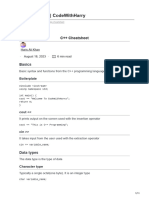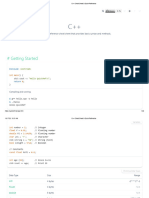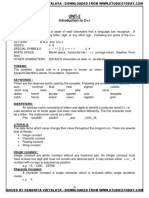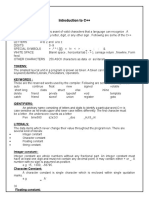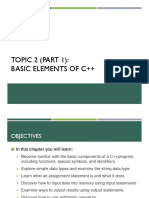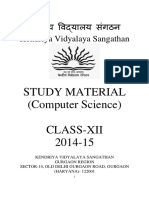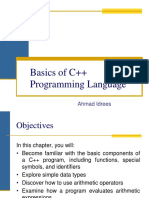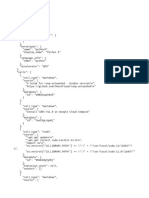7/18/25, 12:44 PM C++ Cheatsheet | Blog | CodeWithHarry
</>CodeWithHarry
Start Learning Tutorials
C++ Cheatsheet
"C++ cheatsheet for programmers coding in C++"
By CodeWithHarry Updated: 5 April 2025
Basics
Basic syntax and functions from the C++ programming language.
Boilerplate
#include <iostream>
using namespace std;
int main() {
cout << "Welcome To CodeWithHarry";
return 0;
}
https://www.codewithharry.com/blogpost/cpp-cheatsheet 1/18
�7/18/25, 12:44 PM C++ Cheatsheet | Blog | CodeWithHarry
cout <<
It prints output on the screen used with the insertion operator.
cout << "This is C++ Programming";
cin >>
It takes input from the user used with the extraction operator.
cin >> variable_name;
Data types
The data type is the type of data.
Character type
Typically a single octet (one byte). It is an integer type.
char variable_name;
Integer type
The most natural size of integer for the machine.
int variable_name;
Float type
A single-precision floating-point value.
float variable_name;
https://www.codewithharry.com/blogpost/cpp-cheatsheet 2/18
�7/18/25, 12:44 PM C++ Cheatsheet | Blog | CodeWithHarry
Double type
A double-precision floating-point value.
double variable_name;
Void type
Represents the absence of the type.
void
Boolean type
bool
Escape Sequences
It is a sequence of characters starting with a backslash, and it doesn't represent itself when
used inside a string literal.
Alarm or Beep
It produces a beep sound.
cout << "\a";
Backspace
It adds a backspace.
cout << "\b";
https://www.codewithharry.com/blogpost/cpp-cheatsheet 3/18
�7/18/25, 12:44 PM C++ Cheatsheet | Blog | CodeWithHarry
Form feed
cout << "\f";
Newline
Newline Character.
cout << "\n";
Carriage return
cout << "\r";
Tab
It gives a tab space.
cout << "\t";
Backslash
It adds a backslash.
cout << "\\";
Single quote
It adds a single quotation mark.
cout << "\'";
https://www.codewithharry.com/blogpost/cpp-cheatsheet 4/18
�7/18/25, 12:44 PM C++ Cheatsheet | Blog | CodeWithHarry
Question mark
It adds a question mark.
cout << "\?";
Octal No.
It represents the value of an octal number.
cout << "\nnn";
Hexadecimal No.
It represents the value of a hexadecimal number.
cout << "\xhh";
Null
The null character is usually used to terminate a string.
cout << "\0";
Comments
A comment is a code that is not executed by the compiler, and the programmer uses it to keep
track of the code.
Single line comment
// It's a single line comment
https://www.codewithharry.com/blogpost/cpp-cheatsheet 5/18
�7/18/25, 12:44 PM C++ Cheatsheet | Blog | CodeWithHarry
Multi-line comment
/* It's a
multi-line
comment
*/
Strings
It is a collection of characters surrounded by double quotes.
Declaring String
// Include the string library
#include <string>
// String variable
string variable1 = "Hello World";
append function
It is used to concatenate two strings.
string firstName = "Harry ";
string lastName = "Bhai";
string fullName = firstName.append(lastName);
cout << fullName;
length function
It returns the length of the string.
string variable1 = "CodeWithHarry";
cout << "The length of the string is: " << variable1.length();
https://www.codewithharry.com/blogpost/cpp-cheatsheet 6/18
�7/18/25, 12:44 PM C++ Cheatsheet | Blog | CodeWithHarry
Accessing and changing string characters
string variable1 = "Hello World";
variable1[1] = 'i';
cout << variable1;
Maths
C++ provides some built-in math functions that help the programmer to perform mathematical
operations efficiently.
max function
It returns the larger value among the two.
cout << max(25, 140);
min function
It returns the smaller value among the two.
cout << min(55, 50);
sqrt function
It returns the square root of a supplied number.
#include <cmath>
cout << sqrt(144);
ceil function
It returns the value of x rounded up to its nearest integer.
https://www.codewithharry.com/blogpost/cpp-cheatsheet 7/18
�7/18/25, 12:44 PM C++ Cheatsheet | Blog | CodeWithHarry
double a = ceil(1.9);
floor function
It returns the value of x rounded down to its nearest integer.
double a = floor(1.02);
pow function
It returns the value of x to the power of y.
int a = pow(x, y);
Decision Making Instructions
Conditional statements are used to perform operations based on some condition.
If Statement
if (condition) {
// This block of code will get executed, if the condition is True
}
If-else Statement
if (condition) {
// If condition is True then this block will get executed
} else {
// If condition is False then this block will get executed
}
if else-if Statement
https://www.codewithharry.com/blogpost/cpp-cheatsheet 8/18
�7/18/25, 12:44 PM C++ Cheatsheet | Blog | CodeWithHarry
if (condition) {
// Statements;
} else if (condition) {
// Statements;
} else {
// Statements
}
Ternary Operator
It is shorthand of an if-else statement.
variable = (condition) ? expressionTrue : expressionFalse;
Switch Case Statement
It allows a variable to be tested for equality against a list of values (cases).
switch (expression) {
case constant-expression:
statement1;
statement2;
break;
case constant-expression:
statement;
break;
...
default:
statement;
}
Iterative Statements
Iterative statements facilitate programmers to execute any block of code lines repeatedly and
can be controlled as per conditions added by the programmer.
while Loop
https://www.codewithharry.com/blogpost/cpp-cheatsheet 9/18
�7/18/25, 12:44 PM C++ Cheatsheet | Blog | CodeWithHarry
It iterates the block of code as long as a specified condition is True.
while (/* condition */) {
/* code block to be executed */
}
do-while loop
It is an exit controlled loop. It is very similar to the while loop with one difference, i.e., the body
of the do-while loop is executed at least once even if the condition is False.
do {
/* code */
} while (/* condition */);
for loop
It is used to iterate the statements or a part of the program several times. It is frequently used
to traverse the data structures like the array and linked list.
for (int i = 0; i < count; i++) {
/* code */
}
Break Statement
break keyword inside the loop is used to terminate the loop.
break;
Continue Statement
continue keyword skips the rest of the current iteration of the loop and returns to the starting
point of the loop.
https://www.codewithharry.com/blogpost/cpp-cheatsheet 10/18
�7/18/25, 12:44 PM C++ Cheatsheet | Blog | CodeWithHarry
continue;
References
Reference is an alias for an already existing variable. Once it is initialized to a variable, it
cannot be changed to refer to another variable. So, it's a const pointer.
Creating References
string var1 = "Value1"; // var1 variable
string &var2 = var1; // reference to var1
Pointers
Pointer is a variable that holds the memory address of another variable.
Declaration
datatype *var_name;
var_name = &variable2;
Functions & Recursion
Functions are used to divide an extensive program into smaller pieces. It can be called
multiple times to provide reusability and modularity to the C program.
Function Definition
https://www.codewithharry.com/blogpost/cpp-cheatsheet 11/18
�7/18/25, 12:44 PM C++ Cheatsheet | Blog | CodeWithHarry
return_type function_name(data_type parameter...) {
// code to be executed
}
Function Call
function_name(arguments);
Recursion
Recursion is when a function calls a copy of itself to work on a minor problem. And the function
that calls itself is known as the Recursive function.
void recurse() {
... .. ...
recurse();
... .. ...
}
Object-Oriented Programming
It is a programming approach that primarily focuses on using objects and classes. The objects
can be any real-world entities.
class
class Class_name {
public: // Access specifier
// fields
// functions
// blocks
};
object
https://www.codewithharry.com/blogpost/cpp-cheatsheet 12/18
�7/18/25, 12:44 PM C++ Cheatsheet | Blog | CodeWithHarry
Class_name ObjectName;
Constructors
It is a special method that is called automatically as soon as the object is created.
class className { // The class
public: // Access specifier
className() { // Constructor
cout << "Code With Harry";
}
};
int main() {
className obj_name;
return 0;
}
Encapsulation
Data encapsulation is a mechanism of bundling the data, and the functions that use them and
data abstraction is a mechanism of exposing only the interfaces and hiding the implementation
details from the user.
#include <iostream>
using namespace std;
class ExampleEncap {
private:
/* Since we have marked these data members private,
* any entity outside this class cannot access these
* data members directly, they have to use getter and
* setter functions.
*/
int num;
char ch;
public:
/* Getter functions to get the value of data members.
* Since these functions are public, they can be accessed
https://www.codewithharry.com/blogpost/cpp-cheatsheet 13/18
�7/18/25, 12:44 PM C++ Cheatsheet | Blog | CodeWithHarry
* outside the class, thus provide the access to data members
* through them
*/
int getNum() const {
return num;
}
char getCh() const {
return ch;
}
/* Setter functions, they are called for assigning the values
* to the private data members.
*/
void setNum(int num) {
this->num = num;
}
void setCh(char ch) {
this->ch = ch;
}
};
int main() {
ExampleEncap obj;
obj.setNum(100);
obj.setCh('A');
cout << obj.getNum() << endl;
cout << obj.getCh() << endl;
return 0;
}
File Handling
File handling refers to reading or writing data from files. C++ provides some functions that
allow us to manipulate data in the files.
Creating and writing to a text file
#include <iostream>
#include <fstream>
using namespace std;
https://www.codewithharry.com/blogpost/cpp-cheatsheet 14/18
�7/18/25, 12:44 PM C++ Cheatsheet | Blog | CodeWithHarry
int main() {
// Create and open a text file
ofstream MyFile("filename.txt");
// Write to the file
MyFile << "File Handling in C++";
// Close the file
MyFile.close();
}
Reading the file
It allows us to read the file line by line.
getline()
Opening a File
It opens a file in the C++ program.
void open(const char* file_name, ios::openmode mode);
in
Opens the file to read (default for ifstream).
fs.open("test.txt", std::fstream::in);
out
Opens the file to write (default for ofstream).
fs.open("test.txt", std::fstream::out);
https://www.codewithharry.com/blogpost/cpp-cheatsheet 15/18
�7/18/25, 12:44 PM C++ Cheatsheet | Blog | CodeWithHarry
binary
Opens the file in binary mode.
fs.open("test.txt", std::fstream::binary);
app
Opens the file and appends all the outputs at the end.
fs.open("test.txt", std::fstream::app);
ate
Opens the file and moves the control to the end of the file.
fs.open("test.txt", std::fstream::ate);
trunc
Removes the data in the existing file.
fs.open("test.txt", std::fstream::trunc);
nocreate
Opens the file only if it already exists.
fs.open("test.txt", std::fstream::nocreate);
noreplace
Opens the file only if it does not already exist.
https://www.codewithharry.com/blogpost/cpp-cheatsheet 16/18
�7/18/25, 12:44 PM C++ Cheatsheet | Blog | CodeWithHarry
fs.open("test.txt", std::fstream::noreplace);
Closing a file
It closes the file.
myfile.close();
Exception Handling
An exception is an unusual condition that results in an interruption in the flow of the program.
try and catch block
A basic try-catch block in C++. When the try block throws an error, the control goes to the
catch block.
try {
// code to try
throw exception; // If a problem arises, then throw an exception
}
catch () {
// Block of code to handle errors
}
Download this Cheatsheet
Tags
Share
cpp cheatsheet
Main Learn
Home Courses
https://www.codewithharry.com/blogpost/cpp-cheatsheet 17/18




